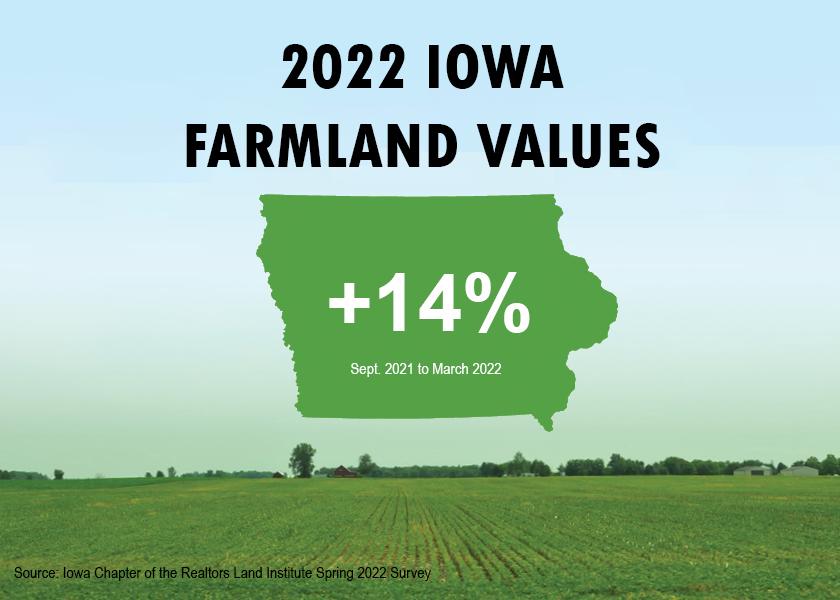Iowa Farmland Soars 14% Higher in Past Six Months

The value of an average acre of Iowa cropland rocketed an astonishing 14.1% higher in the six-month period ending March 1. That’s according to the semi-annual survey conducted by the Iowa Chapter of the Realtors Land Institute.
“Adding that six-month rise with the 18.9% gain posted from March 1, 2021, to September results in an annual increase of nearly 33%,” says Elliot Siefert, Hertz Real Estate Services, Nevada, Iowa, and co-chair of the survey.
Leading gains is the 19.4% burst posted in the southwest crop reporting district. That is followed by a 16.3% increase in the west central district and a 16.1% in the northwest district. The smallest six-month gain was 10.2% marked by the east central district.
On an annual basis, the southwest district is still the leader with a 39.1% explosion. That’s followed by a 35% surge in the northeast district and 33% gains in the both the central and north central districts. The southeast district notched the lowest annual increase at 30.8% followed by a 31.1% gain in the south central district.
The primary driver behind the staggering upswing in cropland values is high commodity prices, report 71% of survey respondents. Some 44% noted low interest as the second key factor followed by 35% listing limited number of farms for sale as the third. Some 19% listed concerns about inflation as a key factor. That compares to 60% who said it was the least important factor just a year earlier, notes Matt Vegter, Hertz Real Estate Service, Nevada, and the other co-chair of the survey.
Going forward, the key negative likely to impact land values in an increase in interest rates, says Vegter. However, strong commodity prices and a continuing limit on the number of farms available for purchase will be important positive factors going forward. Vegter also says the strong surge in input costs will negate some of the positive impact of high commodity prices.
The survey pegs the state-wide value of high-quality cropland at $14,080 an acre, up 14.1% from September; the value of medium-quality cropland at $10,902, up 14.2%; and the value of low-quality cropland at $7,701 an acre, up 13.7%.
In addition to cropland values, the survey lists a gain of 12.3% in the value of pastureland. The northwest district notes a six-month increase of 16% to an average of $4,630. The north-central district reports the smallest percentage increase of 10.3% to an average value of $3,986.
Timber land also rose, notching a gain of 11.3% to an average value of $3,784.
According to the survey, some 64% of all buyers were farmers and the remaining 36% were investors. Of the investor group, just over half, 52%, were local investors and 48% were non-local investors, some with 1031 money.







